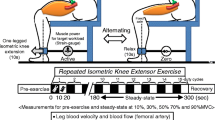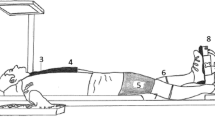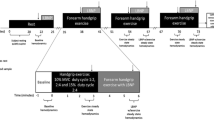Abstract
Studies of whole limb blood flow have shown that static handgrip elicits a vasodilatation in the resting forearm and vasoconstriction in the resting leg. We asked if these responses occur in the skeletal muscle vascular bed, and if so, what is the relative contribution of local metabolic versus other mechanisms to these vascular responses. Blood flow recordings were made simultaneously in the skeletal muscle of the resting arm and leg using the Xenon-washout method in ten subjects during 3 min of isometric handgrip at 30% of maximal voluntary contraction. In the arm, skeletal muscle vascular resistance (SMVR) decreased transiently at the onset of exercise followed by a return to baseline levels at the end of exercise. In the leg SMVR remained unchanged during the 1st min of handgrip, but had increased to exceed baseline levels by the end of exercise. During exercise electromyography (EMG) recordings from nonexercising limbs demonstrated a progressive 20-fold increase in activity in the arm, but remained at baseline in the leg. During EMG-signal modelled exercise performed to mimic the inadvertent muscle activity, decreases in forearm SMVR amounted to 57% of the decrease seen with controlateral handgrip. The present study would seem to indicate that vascular tone in nonexercising skeletal muscle in the arm and leg are controlled differently during the early stages of static handgrip. Metabolic vasodilatation due to involuntary contraction could significantly modulate forearm skeletal muscle vascular responses, but other factors, most likely neural vasodilator mechanisms, must make major contributions. During the later stages of contralateral sustained handgrip, vascular adjustments in resting forearm skeletal muscle would seem to be the final result of reflex sympathetic vasoconstrictor drive, local metabolic vasodilator forces and possibly neurogenic vasodilator mechanisms.
Similar content being viewed by others
References
Asmussen A (1981) Similarities and dissimilarities between static and dynamic exercise. Circ Res 48 [Suppl 1]:13–110
Bertocci LA, Scherrer U, Pryor SL, Victor RG (1990) Does the exercise pressor reflex alleviate muscle hypoperfusion during static contraction? Circulation 82 [Suppl III]:III-692
Bigland B, Lippold CC (1954) Relationship between force, velocity and integrated electrical activity in human muscle. J Physiol (Lond) 123:214–224
Byström SEG, Kilbom Å (1990) Physiological response in the forearm during and after isometric intermittent handgrip. Eur J Appl Physiol 60:457–466
Eklund BL, Kaijser L (1976) Effect of regional alpha and betaadrenergic blockade on blood flow in resting forearm during contralateral isometric handgrip. J Physiol (Lond) 262:39–50
Eklund BL, Kaijser L, Knutsson E (1974) Blood flow in the resting (contralateral) arm and leg during isometric contraction. J Physiol (Lond) 140:111–124
Gaffney FA, Sjøgaard G, Saltin B (1990) Cardiovascular and metabolic responses to static contraction in man. Acta Physiol Scand 138:249–258
Galbo H (1983) Hormonal and metabolic adaptation to exercise. Thieme-Stratton, New York
Hansen J, Jacobsen TN, Amtorp O (1993) The exercise pressor response to sustained handgrip does not augment blood flow in the contracting forearm skeletal muscle. Acta Physiol Scand 149:419–425
Kety SS (1951) Theory and application of the exchange of inert gas at the lungs and tissues. Pharmacol Rev 3:1–41
Kilbom Å, Brundin T (1976) Circulatory effects of isometric muscle contractions, performed separately and in combination with dynamic exercise. Eur J Appl Physiol 36:7–17
Lassen NA, Henriksen O, Sejrsen P (1983) Indicator methods for measurements of organ and tissue flow. In: Abboud FM, Shepherd JT (eds) Handbook of physiology III. The cardiovascular system. American Physiological Society, Washington D.C., pp 21–63
Lind AR, Dahms TE, Williams CA, Petrofsky JS (1981) The blood flow through the resting arm during handgrip contractions. Circ Res 48 [Suppl 1]:104–109
Lindberg IF, Andersen AM, Munck O, Jørgensen M (1966) The fat content of leg muscle and its influence of the133Xe clearance method for blood flow measurements. Scand J Clin Lab Invest 18:525
Mark AL, Victor RG, Nerhed C, Wallin BG (1985) Microneurographic studies of the mechanisms of sympathetic nerve responses to static exercise in humans. Circ Res 57:461–469
Martin CE, Shaver JA, Leon DF, Thompson ME, Reddy PS, Leonard JJ (1974) Autonomic mechanisms in hemodynamic responses to isometric exercise. J Clin Invest 54:104–5
Milner-Brown HS, Stein RB (1975) The relation between the surface electromyogram and muscular force. J Physiol (Lond) 246:549–569
Mitchell JH, Kaufman MP, Iwamoto GA (1983) The exercise pressor reflex: its cardiovascular effects, afferent mechanisms, and central pathways. Annu Rev Physiol 45:229–242
Morgan BJ, De Boer LWV, Pease MO, Scherrer V, Vissing SF, Hanson P (1991) Forearm vascular resistance increases during static exercise in heart transplant recipients. J Appl Physiol 76:2224–2230
Ray CA, Rea RF, Clary MP, Mark AL (1992) Muscle sympathetic nerve responses to static leg exercise. J Appl Physiol 73:1523–1529
Rowell LB (1993) Human cardiovascular control. Oxford University Press, Oxford
Rusch NJ, Shepherd JT, Webb RG, Vanhoutte PM (1981) Different behavior of the resistance vessels in the human calf, and forearm during contralateral isometric exercise, mental stress and abnormal respiratory movements. Circ Res 48 [Suppl 1]:118–130
Saito M, Mano T, Iwase S (1990) Changes in muscle sympathetic nerve activity and calf blood flow during static handgrip exercise. Fur J Appl Physiol 60:277–281
Sanders JS, Mark AL, Ferguson DW (1989) Evidence for cholinergically mediated vasodilation in the beginning of isometric exercise in humans. Circulation 79:815–824
Seals DR (1989) Sympathetic neural discharge and vascular resistance during exercise in humans. J Appl Physiol 66:2472–2478
Seals DR, Victor RG (1990) Regulation of muscle sympathetic nerve activity during exercise in humans. In: Holloszy J (ed) Exercise and sport sciences reviews, vol 19. Williams Wilkins, Baltimore, pp 313–349
Sejrsen P, Tønnesen KH (1972) Shunting by diffusion of inert gas in skeletal muscle. Acta Physiol Scand 86:82–91
Shepherd JT, Blomquist GC, Lind AR, Mitchell JR, Saltin B (1981) Static (isometric) exercise: retrospection and introspection. Circ Res 48 [Suppl 11: I179-I188
Sinoway L, Prophet S (1990) Skeletal muscle metaboreceptor stimulation opposes peak metabolic vasodilation in humans. Circ Res 66:1576–84
Sjøgaard G, Savard G, Juel C (1988) Muscle blood flow during isometric activity and its relation to muscle fatigue. Eur J Appl Physiol 57:327–335
Taylor JA, Joyner MJ, Chase PB, Seals DR (1989a) Differential control of forearm and calf vascular resistance during one-leg exercise. J Appl Physiol 67:1791–1800
Taylor WIT, Johnson JM, Koshiba WA, Kwan CM (1989b) Cutaneous vascular responses to isometric handgrip exercise. J Appl Physiol 66:1586–92
Tønnesen KH, Sejrsen P (1970) Washout of 133Xenon after intramuscular injection and direct measurement of blood skeletal muscle. Scand J Clin Lab Invest 25:71–81
Vissing SF, Scherrer U, Victor RG (1991) Stimulation of skin sympathetic nerve discharge by central command. Circ Res 69:228–38
Wallin BG, Victor RG, Mark AL (1989) Sympathetic outflow to resting muscles during static handgrip and post-contraction muscle ischemia. Am J Physiol 256:H105-H110
Author information
Authors and Affiliations
Rights and permissions
About this article
Cite this article
Jacobsen, T.N., Hansen, J., Nielsen, H.V. et al. Skeletal muscle vascular responses in human limbs to isometric handgrip. Europ. J. Appl. Physiol. 69, 147–153 (1994). https://doi.org/10.1007/BF00609407
Accepted:
Issue Date:
DOI: https://doi.org/10.1007/BF00609407




